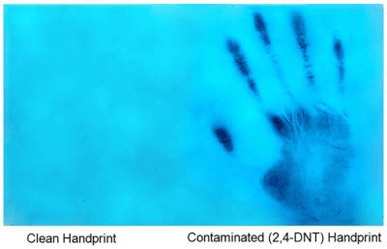According to a statement, the key to the system is a fluorescent nanofibrous film that can detect ultra-trace levels of explosive vapours and buried explosives when applied to an area where explosives are suspected. A chemical reaction marking the location of the explosive device occurs when the film is exposed to handheld ultraviolet light.
The system can reportedly detect nitroaromatics such as those found in TNT and 2,4-DNT (the military’s primary explosive and the principal component in landmines) as well as the elements used in harder-to-detect plastic explosives such as HMX, RDX, Tetryl and PETN.
The ultra-sensitive system can detect elements at levels as low as 10 parts per billion (TNT), 74 parts per trillion (Tetryl), five parts per trillion (RDX), seven parts per trillion (PETN) and 0.1 parts per trillion (HMX) released from one billionth of a gram of explosive residue.
If there is no explosive vapour present, the recyclable film retains a bright fluorescent cyan blue colour when exposed to ultraviolet light. If explosive molecules are present, the fluorescence is quenched and a dark circle identifying the threat forms on the film within minutes.
‘Our initial results have been very promising,’ said UConn’s Dr Ying Wang, who developed the system as a chemical engineering doctoral student working under the supervision of UConn associate engineering professor Yu Lei. ‘We are now in the process of arranging a large-scale field test in Sweden.’
Rather than using sophisticated chemical modifications or costly synthetic polymers in preparing the sensing material, UConn scientists prepared their ultra-thin film by electrospinning pyrene with polystyrene in the presence of an organic salt (tetrabutylammonium hexafluorophosphate or TBAH).
This is said to have resulted in a highly porous nanofibrous membrane that absorbs explosive vapours at ultra-trace levels quickly and reliably. The film also has excellent sensitivity against common interferences such as ammonium nitrate and inorganic nitrates. Initial vapour detection took place within seconds, with more than 90 per cent fluorescent quenching efficiency within six minutes.

While explosive material can be concealed within landmines and improvised explosive devices (IEDs), the seal is often not airtight and small amounts of vapours escape allowing for detection.
The film developed by Wang and Lei is very light in weight, similar to paper, and can be rolled out over a suspect area such as a sheet. The electrospinning process makes it easy and affordable to produce.
The research was first reported in the 11 May 2012 online edition of Advanced Functional Materials.




April 1886: the Brunkebergs tunnel
First ever example of a ground source heat pump?